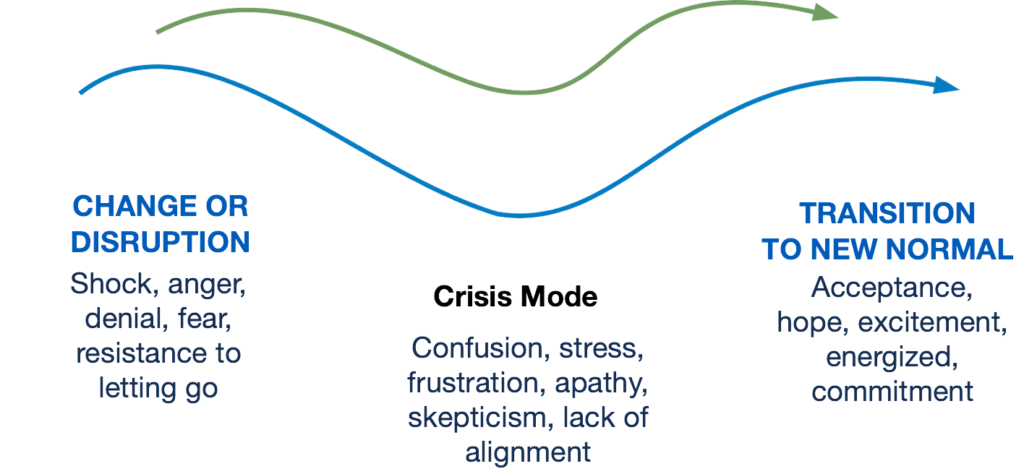2020 was a year of substantial change. Individuals and companies dealt with global pandemic, distanced work and learning, racial injustice, and a contentious election year. While this past year was unusual in its intensity, change and disruption will happen. No business is exempt from major disruption over time.
As leaders, how we help our teams navigate change and handle the transition is critical to our company’s success. The company that embraces the change, adjustment, and adaptation cycle will continue to thrive regardless of external influence.
So, a question for you – Is your leadership poised and ready to step up and take charge of change?
The Change Curve
First, let’s define some key terms. Change or disruption is an influence that is a situational, developmental, or external event. Transition is an internal process, a psychological response, a mental and emotional process to the new normal.
Transition involves “the process of letting go of the way things used to be and the subsequent embracing of new opportunities and growth.”

Phases of Change
Initial Shock from Change
When a dramatic change happens there is a natural inclination for people to be shocked, in denial, fearful, and maybe even angry. The initial response is often resistance to letting go of the old model.
Crisis Mode
The next step is crisis mode where employees try to make sense of what is happening and try to find direction. People will have a variety of responses varying from confusion, stress, frustration, to skepticism and apathy. There may be a lack of alignment on how to move forward.
Transition to New Normal
With strong leadership, eventually the tides turn and the transition to the new normal occurs. In a successful transition your employees will move toward acceptance of the new model with renewed hope and excitement. They will be energized and committed to the new direction.
Keep in mind, given the statistics on the volatility in employee engagement, your employees may cycle through stages back to an earlier stage. It is important for us as leaders to meet individuals where they are in their journey and help them navigate through as quickly as possible.
“The secret of change is to focus all of your energy, not on fighting the old, but on building the new.”
~ Socrates
How Do We Get There?
During the disruption phase, leaders need to use their emotional intelligence leadership skills to provide empathy, clear and transparent communication, and build trust.
During crisis mode, leaders need to cultivate their thinking skills. Initiative and decisive action are critical at this stage. It is imperative to set a compelling vision and engage the team in identifying a clear, actionable path forward. Critical thinking, change management, strategic thinking, and agility are key.
Finally, in order to successfully transition to the new normal, leaders need to lead by instinct. Once the data has been reviewed and the new strategic plan is in place, the leader must act from his or her authentic self to bring those plans to life.
It is important to be agile and able to adapt as circumstances dictate. Leverage your team and talent leadership skills by inspiring confidence, encouraging and empowering others, and model the way to success. Celebrate the wins along the way!
It is important to note that clear, concise, and compelling communication is key across all stages of the change curve.
Planning for Change
The companies that succeed in the new normal of 2021 and beyond are those that acknowledge that change is constant and prepare for that change. When we equip our leaders and employees with the competencies, they need to address disruption, we are better able to successfully adapt and survive in changing circumstances.



